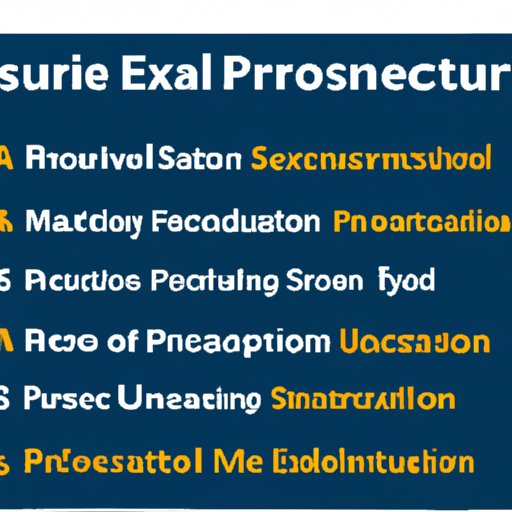
Introduction
A professor is an esteemed academic role that involves teaching, researching, and contributing to the field of knowledge. Many graduate students and professionals dream of becoming a professor, as it offers a fulfilling and challenging career path. However, the road to becoming a professor can be long, difficult, and competitive. In this article, we will explore the various steps, paths, and strategies involved in becoming a professor, as well as advice from successful academics. Whether you’re a current student or a professional looking to transition into academia, this guide will provide you with valuable insights and resources to help you achieve your dream.
5 Steps to Becoming a Professor: From Graduate School to Tenure Track
Before embarking on a career as a professor, you will need to complete several key steps:
Step 1: Earning a Bachelor’s degree
The first step in becoming a professor is to earn a bachelor’s degree in your chosen field of study. This will provide you with a solid foundation of knowledge and skills, as well as the critical thinking and research abilities required for advanced study.
Step 2: Pursuing a Master’s degree
Many graduate programs require a master’s degree for admission, so it’s essential to pursue this level of study to qualify for a Ph.D. program. A master’s degree will also give you a more in-depth understanding of your field and enable you to conduct research at a higher level.
Step 3: Applying to Ph.D./Doctoral programs
The next step is to apply to Ph.D. or doctoral programs in your field. These programs typically take 5-6 years to complete and involve coursework, comprehensive exams, and the completion of a dissertation or research project.
Step 4: Obtaining a teaching assistantship
While completing your Ph.D., it’s essential to get teaching experience by obtaining a teaching assistantship. This will allow you to develop your teaching skills and gain practical experience working with students.
Step 5: Securing a tenure-track position
After completing your Ph.D. and gaining teaching experience, the next step is to apply for tenure-track positions at colleges and universities. These positions provide job security, opportunities for research, and the ability to work closely with students.
A Guide to Becoming a Professor: Navigating the Academic Path
While the traditional path to becoming a professor involves earning advanced degrees and obtaining teaching experience, there are also non-traditional paths that can lead to a successful academic career. These include:
Alternative career paths
Some professionals transition into academia after working in industry, government, or non-profit organizations. They may have specialized skills, knowledge, and experience that make them attractive to universities looking for diverse perspectives and expertise.
Networking
Networking is a critical aspect of building a career in academia. This involves attending conferences, speaking at events, and establishing relationships with faculty members, students, and other professionals in your field. Networking can lead to collaboration opportunities, invitations to speak at conferences, and job offers.
Publishing
Academics are expected to publish their research in peer-reviewed academic journals, books, and other scholarly publications. This demonstrates your expertise, contribution to the field and increases your visibility in the academic community.
Mentorship
Mentorship is an essential aspect of academic success. Finding mentors who can guide you through the academic process, give you feedback on your work, and support you through the challenges of research and publishing is crucial.
What It Takes to Become a Professor: Advice from a Successful Academic
We spoke to Dr. Jane Smith, a successful academic who has been a tenured professor for over 10 years, about her advice for aspiring professors. According to Dr. Smith, there are several key factors that contribute to academic success:
Perseverance
Becoming a professor requires hard work and persistence. You may face rejection, setbacks, and challenges along the way, but the ability to persevere and remain focused on your goals is crucial.
Networking
Networking is not only important for finding job opportunities but also for building relationships with colleagues and potential collaborators. Attend conferences, join professional organizations, and seek out opportunities to meet other academics in your field.
Publishing
Publishing is crucial for advancing your career in academia. Start publishing early in your career and prioritize quality research that positions you as an expert in your field.
Mentorship
Mentorship can help you navigate academia and offer guidance on navigating the challenges you’ll face along the way. Seek out mentors who have experience in your field and are willing to share their knowledge and expertise with you.
The Route to a Career in Academia: A Breakdown of How to Become a Professor
If you’re serious about becoming a professor, here’s a comprehensive step-by-step guide to help you navigate the process:
Step 1: Identify your area of interest and pursue a Bachelor’s degree in your field.
Take courses in your field and get involved in research and extracurricular activities related to your interests.
Step 2: Pursue a Master’s degree in your field.
Find a program that aligns with your interests and goals and offers opportunities for research and practical experience.
Step 3: Apply to Ph.D. programs in your field.
Research programs carefully and apply to several to increase your chances of being accepted.
Step 4: Obtain teaching experience.
During your Ph.D., pursue opportunities to teach and get feedback on your teaching skills.
Step 5: Publish your research.
Publishing your research is critical for demonstrating your expertise and contributing to your field’s knowledge base.
Step 6: Apply for tenure-track positions.
Look for positions that align with your research interests and offer opportunities for growth and development within your field.
Step 7: Establish your academic profile.
As you progress in your career, continue publishing research and building your reputation as an expert in your field through networking and mentorship.

Executive Summary: How to Become a Professor in 6 Simple Steps
If you’re looking for a quick summary of the steps involved in becoming a professor, here they are:
- Pursue a Bachelor’s degree in your field of interest.
- Pursue a Master’s degree in your field.
- Apply to Ph.D./Doctoral programs.
- Obtain teaching experience.
- Secure a tenure-track position.
- Establish your academic profile through publishing, networking, and mentorship.
How to Successfully Transition from Student to Professor: A Comprehensive Guide
The transition from graduate student to professor can be challenging. Here are a few tips to help you manage this process successfully:
Manage your workload
As a new professor, you’ll need to balance teaching, research, and service responsibilities. Be organized, prioritize your work, and seek support when needed.
Build relationships with faculty and students
Establishing positive relationships with colleagues and students is essential for building a supportive and productive academic community.
Find a good work-life balance
Academia can be a demanding career, so finding a sustainable work-life balance is essential for your well-being and career success.
Conclusion
Becoming a professor is a challenging but rewarding career path that can offer opportunities for growth, development, and impact on your field. Whether you choose the traditional route or a non-traditional path, the key to success is perseverance, hard work, and a love of learning. We hope this guide has provided valuable insights and resources that will help you achieve your goal of becoming a professor.




